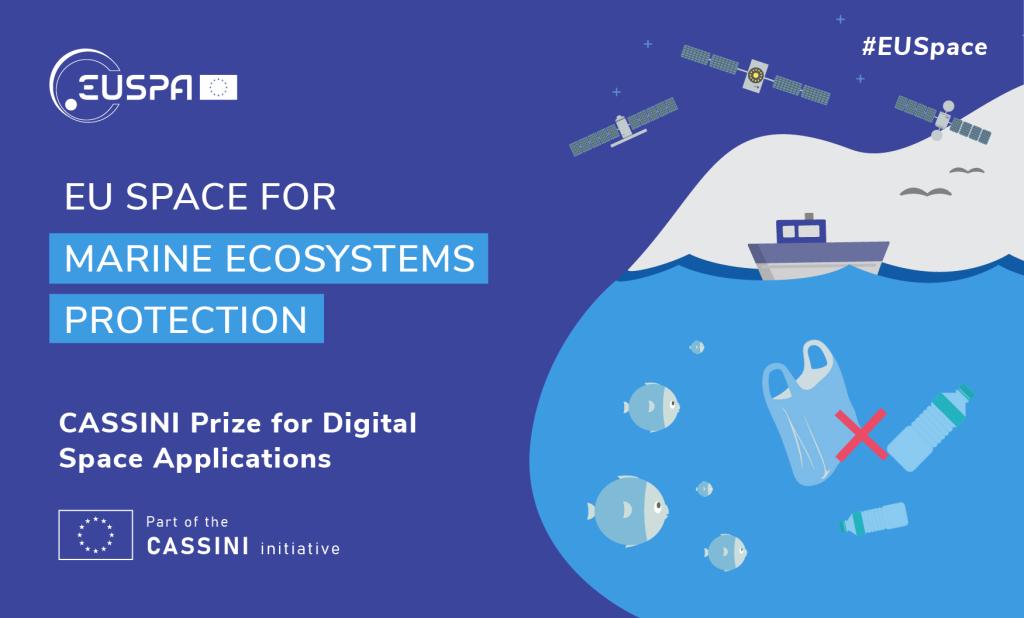Wanted: space-based solutions for solving the oceans’ plastic problem

The EU Agency for the Space Programme (EUSPA) is supporting a new prize contest. The competition is looking for solutions that leverage Earth Observation and GNSS to detect, monitor and remove plastic in oceans and waterways. Read on to learn more about the global issue spurring the need for these types of solutions and the CASSINI competition initiative.
The growing problem of plastic in oceans and waterways
Of the 300 million tons of plastic produced every year, an estimated 26 million eventually ends up in the ocean. As a result, some estimates suggest there are now 5.25 trillion pieces of plastic in our oceans and seas. Even more concerning is the fact that this number is expected to increase, with National Geographic predicting that the annual amount of plastic flowing into the oceans will triple by 2040.
As the International Union for Conservation of Nature explains, in addition to causing climate change and impacting the coastal tourism industry, plastic litter also threatens marine ecosystems. That’s because when plastic litter is exposed to sunlight, wind and currents, it breakdowns to become microplastics. These microplastics can be easily ingested by marine life, resulting in severe injuries, health problems and even death – all of which could impact our own food security and safety.
Space’s plastic removal potential
Solving the ocean’s plastic problem starts with taking the litter out of the water. But this requires first knowing where the plastic is, which is where Earth Observation and GNSS come into play.
Earth Observation has the potential to help detect and monitor plastic pollution across the oceans. According to an Observer article, by using data on ocean currents collected by the Copernicus Marine Service, in combination with other information, one can monitor how and where plastics enter the ocean and determine how long they have been there.
GNSS can also play a role in cleaning up our oceans. In 2019, a California-based cargo ship used GNSS positioning to track and collect a mass of plastic floating in the Pacific Ocean that is thought to be three times the size of France. The initiative had mariners place reusable GNSS trackers on the discarded fishing nets that tend to accumulate plastics. The cargo ship then tracked these devices to collect both the nets and plastic waste. In total, 40 tonnes of plastic were removed.
But these examples only scratch the surface of what Earth Observation, GNSS and their synergistic use are capable of. To fully leverage these technologies and their plastic removal potential, EUSPA is supporting a new prize contest.
A chance to win funding for your commercial solution
The CASSINI Prize for Digital Space Apps is looking for innovative commercial solutions that leverage the EU Space Programme to detect, monitor and remove plastics, microplastics and other litter from our oceans and waterways. With a total prize purse of EUR 2.85 million, the top three proposals are eligible to win EUR 0.95 million each, which can be used to help further develop and commercialise your solution.
CASSINI is the European Commission’s initiative to support entrepreneurs, start-ups and SMEs developing innovative applications and services that leverage the EU Space Programme. Dedicated to promoting the commercialisation of Galileo, EGNOS and Copernicus data and services, EUSPA is actively involved in the initiative.
Because the contest aims to create a new ecosystem of entrepreneurs, applications are only open to SMEs. All proposed solutions must be close-to-market and be able to prove their effectiveness in a real-world demonstration.
The prize is foreseen as part of the Horizon Europe Work Programme.
More information can be found here.
Media note: This feature can be republished without charge provided the European Union Agency for the Space Programme (EUSPA) is acknowledged as the source at the top or the bottom of the story. You must request permission before you use any of the photographs on the site. If you republish, we would be grateful if you could link back to the EUSPA website (http://www.euspa.europa.eu).